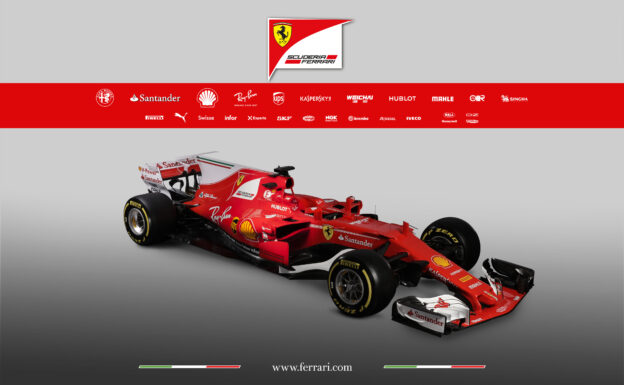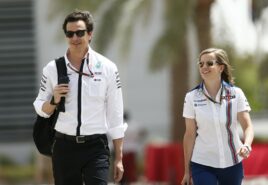Ferrari Launches their SF70H

This morning Ferrari launched their 2017 F1 season competitor, the SF70-H.
At 9:45 CET the 1 minute! presentation started of the new racing car on the official Ferrari F1 website. The video showed an historical introduction from the rich history of Scuderia Ferrari and went to a countdown to launch the red racingcar.
The first shot we saw next was a garage door that opened up. Behind the door was the car in it's full glory with the team bosses and both race drivers Sebastian Vettel and Kimi Raikkonen. Next to the both of them was test driver Antonio Giovinazzi.
Nothing was said during the 1 minute presentation and Kimi Raikkonen showed he could appreciate it by putting up a big smile. After the launch of last year the Italian team was telling the whole world they would become world champions and the finished 3rd in the championship and couldn't win a single race. So a lower profile is maybe better to start the season with, but as low as we saw this year might be a bit poor.
The SF70-H looks very sophisticated, with a lot of features and wings that we haven't seen yet on other 2017 cars.
The front nose showed extra small wings above the suspension, as can be seen in the image in on the right side.
The whole car is covered with extra wings, tho generate extra down-force. You can see extra wings right behind the camera on the top (black thing above the air in take). Even at the end of the shark fin you see a wing.
Also the air intake of the radiators in front of the side-pods are never seen before. The barge boards are very different.
Underneath you can see the big differences between last years Ferrari car the SF16-H yourself.
- SF70-H VS SF16-H top view
Hopefully for Ferrari all new parts will work next week during testing on the Circuit de Catalunya, so they can be a strong contented against the 2016 World Champions team Mercedes and runner op Red Bull Racing.
You can see more launch pictures on our dedicated Ferrari SF70-H launch pictures page.
The 63rd single-seater designed and built by Scuderia Ferrari to take part in the Formula 1 World Championship is born out of a regulation change that is without precedent in this category of motor sport. Generally, in the past, regulations went in the direction of slowing down the cars. However, this year, the rule changes go in the opposite direction, meaning the cars have more aerodynamic downforce and more mechanical grip.
AERODYNAMIC CONCEPT. On this topic, the Gestione Sportiva group has concentrated its efforts on finding the right compromise between downforce and aerodynamic resistance, or drag. The new Pirelli tyres are much wider than in the past, by 6 centimetres each at the front and 8 at the rear. This increased frontal area constitutes a “brake” on forward motion as does the increased downforce coming from the 2017 specification front wing, floor and diffuser. Countering this effect, the combination of downforce and the bigger footprint from the tyres translates into increased grip, leading to higher cornering speeds.
CHASSIS. There are several differences between the SF70H and Ferrari's from the recent past: the lengthened nose and the arrow-shaped wing are a consequence of the regulations, as is the obvious fin on the engine cover and the more complex aero appendages ahead of the air intakes on the sidepods, whose unusual shape was designed in harmony with the front crash structure. Visible at the front is a duct that has an aerodynamic role, while behind the driver, the roll-hoop, which incorporates the engine air intake has been completely redesigned. Also updated is the suspension layout, which still retains a push rod design at the front with pull rods at the rear. The hubs and wheel nuts have been redesigned to facilitate the work of the mechanics when changing wheels during the pit stops. Finally, also as a function of the expected increase in performance this year, the power-steering and braking systems have been upsized.
POWER UNIT. In contrast to the aerodynamics, when it comes to the power unit, there have been few changes to the regulations. The main one concerns the amount of fuel that can be used by each car during the race: with the predicted increase in performance, with a bigger percentage of each lap spent at full revs, the permitted amount of fuel has increased from 100 to 105 Kg, although the flow rate is still fixed at 100 kg/hour. The 062 engine is a definite step forward compared to its predecessor, when it comes to chasing performance. The layout of some of the mechanical components on the hybrid power unit has been revised, while other areas maintain a similar layout to the 2016 car. On the sporting regulation front, the abolition of the “Token” system allows the teams more room for development over the course of the season.
SF70-H Tecnical Specification
Engine
Capacity 1600 cc
Max revs 15,000
Supercharging Single Turbo
Fuel flow 100 kg/hr max
Fuel capacity 105 kg
Configuration V6 90°
Cylinders 6
Bore 80 mm
Stroke 53 mm
Valves 4 per cylinder
Injection 500 bar – direct
ERS System
Battery energy (per lap) 4 MJ
MGU-K Power 120 kW
MGU-K Max revs 50,000 rpm
MGU-H Max revs 125,000 rpm
Technica Data
Chassis in carbon-fibre and honeycomb composite structure
Ferrari longitudinal gearbox
Servo controlled hydraulic limited-slip differential
Semiautomatic sequential and electronicallycontrolled gearbox with quick shift
Number of gears: 8 +R
Brembo ventilated carbon-fibre disc brakes(front and rear) and brake by wire rear brakes
Pushrod front suspensionPullrod rear suspension
Weight with water, lubricant and driver 728 kg
OZ wheels (front and rear) 13”
✅ Check out more posts with related topics:
















LAST 3 F1 Fan COMMENTS